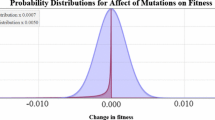Summary
We consider a model with two types of genes (alleles) A1 A2. The population lives in a bounded habitat R, contained in r-dimensional space (r= 1, 2, 3). Let u (t, x) denote the frequency of A 1 at time t and place x ɛ R. Then u (t, x) is assumed to obey a nonlinear parabolic partial differential equation, describing the effects of population dispersal within R and selective advantages among the three possible genotypes A 1 A 1, A 1 A 2, A 2 A 2. It is assumed that the selection coefficients vary over R, so that a selective advantage at some points x becomes a disadvantage at others. The results concern the existence, stability properties, and bifurcation phenomena for equilibrium solutions.
Similar content being viewed by others
References
Aronson, D. G., Weinberger, H. F.: Nonlinear diffusion in population genetics, combustion. and nerve propogation. Proc. Tulane Progr. in Partial Differential Eqns. Springer Lecture Notes in Mathematics, 1975.
Chafee, N.: Asymptotic behaviour for solutions of a one-dimensional parabolic equation with homogeneous Neumann boundary conditions. J. Differential Equations.
Chafee, N.: Behaviour of solutions leaving the neighborhood of a saddle point for a nonlinear evolution equation, preprint.
Conley, C.: An application of Wazewski's method to a nonlinear boundary value problem which arises in population genetics, Univ. of Wisconsin Math. Research Center Tech. Summary Report No. 1444, 1974.
Fisher, R. A.: Gene frequencies in a cline determined by selection and diffusion. Biometrics 6, 353–361 (1950).
Fleming, W. H.: A nonlinear parabolic equation arising from a selection-migration model in genetics. IRIA Seminars Review, 1974.
Haldane, J. B. S.: The theory of a cline. J. Genet. 48, 277–284 (1948).
Hestenes, M. R.: Calculus of Variations and Optimal Control Theory. Wiley 1966.
Hoppensteadt, F. C.: Analysis of a Stable Polymorphism Arising in a Selection-Migration Model in Population Genetics dispersion and selection. J. Math. Biology 2, 235–240 (1975).
Karlin, S.: Population division and migration-selection interaction. Population Genetics and Ecology. Academic Press 1976.
Karlin, S., Richter-Dyn, N.: Some theoretical analysis of migration-selection interaction in a cline: a generalized 2 range environment. Population Genetics and Ecology. Academic Press 1976.
Karlin, S., McGregor J., unpublished.
Lions, J. L.: Équations Differentielles Operationelles. Berlin-Göttingen-Heidelberg: Springer, 1961.
Lions, J. L.: Quelques Méthodes de Résolution des Problèmes aux Limites Nonlinéaires. Dunod, 1969.
Lions, J. L., Magenes, E.: Problèmes aux Limites Non-Homogènes et Applications, vols. I, II. Dunod 1968.
Nagylaki, T.: Conditions for the existence of clines. Univ. of Wisconsin Madison Genetics Lab paper No. 1787, 1974.
Slatkin, M.: Gene flow and selection in a cline. Genetics 75, 733–756 (1973).
Author information
Authors and Affiliations
Additional information
This research was supported by the National Science Foundation under GP-38428 X.
Rights and permissions
About this article
Cite this article
Fleming, W.H. A selection-migration model in population genetics. J. Math. Biology 2, 219–233 (1975). https://doi.org/10.1007/BF00277151
Received:
Issue Date:
DOI: https://doi.org/10.1007/BF00277151




